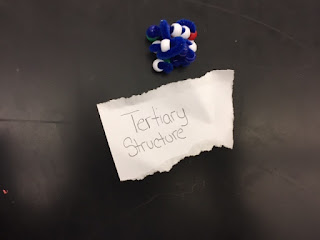Honors Biology and AP Biology have been learning about the four different classes of large organic molecules: carbohydrates, lipids, proteins, and nucleic acids. To aid in their understanding of these abstract concepts, they have built models of these molecules! Check out the photos below.
 |
| Carbohydrates: A disaccharide called maltose, a combination of two monosaccharides of glucose. Each gumdrop represents a different molecule (Red=carbon, Green=oxygen, yellow=hydrogen), and the toothpicks represent the bonds. |
 |
Lipids: A triglyceride with a saturated, monounsaturated, and polyunsaturated fatty acid. The saturated is kept straight to represent a lack of double bonds, the monounsaturated has one bend to represent one double bond, and the polyunsaturated as many bends to represent many double bonds.
|
 |
| Lipids: A phospholipid which contains two fatty acid tails, a glycerol, phosphate, and choline. |
 |
Lipids: A phospholipid bilayer which is organized with individual phospholipids arranged with hydrophobic portions facing inward and hydrophilic portions facing outward.
Proteins: The Primary Structure of Proteins consists of different amino acids (different colors of beads) connected by peptide bonds (blue pipe cleaner) in a single strand
Proteins: The Secondary Structure of Proteins consists of the primary structure being folded to form two structures, the alpha helix and the beta pleated sheet. They structures are held together through hydrogen bonding
Proteins: The tertiary structure of proteins consists of a folded up secondary structure in which the R groups of each individual amino acid interact with one another through ionic bonds, hydrophobic interactions, and disulfide bridges.
Proteins: The quaternary structure of proteins is when multiple protein tertiary structure subunits come together. Notice here, two groups connected their proteins to make an overall structure. An example of this is hemoglobin!
Nucleic Acids: Here is a photograph of a model of DNA and RNA. Notice DNA is doubles stranded and RNA is single stranded. The orange pipe cleaner denote phosphate groups in the sugar phosphate backbones. The blue beads symbolize deoxyribose (sugar in DNA), whereas yellow beads symbolized ribose (sugar in RNA). The paper clips show the different bases. Pink is uracil (only in RNA), red is cytosine, blue is guanine, green is adenine, and yellow is thymine (only present in DNA). The connection between the complementary bases (A-T, G-C) is a hydrogen bond and is demonstrated through the connection between paper clips!
|









No comments:
Post a Comment